
Visiting Milano Milan is an important centre for business and culture, where you can find the old and the new, historical monuments and modern buildings, fashion and churches, museums, art and design.
If you want to visit and discover everything you'll need many days...but if you don't have so much time available, don't worry: you'll be surprised to find that the spirit of this city can be understood even with this essential tour in Milan! 

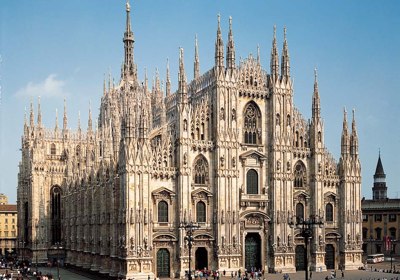
il Duomo The most important church of Milan has been commissioned in 1387 by Gian Galeazzo Visconti, and dedicated to Santa Maria Nascente. It is built on the rests of the S. Tecla' , one of the first churches in Milan, where the first Chiristians were baptised. It's a magnific representative of Gothic architectural style, and it's all made by Candoglia's marble, coming from the Milan's duke properties.
There are more than 3400 statues, and its higher pinnacle has put on the Virgin Mary statue, made out of copper covered with gold leaves, called Madonnina by Milan people. Construction was completed only in 1960, when the last bronze door was put into place, in the front side. Now the conservation of this masterpiece is the task of the Veneranda Fabbrica del Duomo society, and it's rare to see the cathedral without any sign of intervention.
The Cathedral is open from 7.00 until 19.00. Admission free.
Being in a church, you must wear suitable clothes (not shorts, top etc). It's not allowed to take pictures inside the building; remember to switch off, or at least put in "silence" mode, your mobile phone.
We recommend a visit to the top of the Duomo: you'll see a fantastic panorama of Milan. If you're lucky and it's a sunny and clear day, your sight could reach even the mountains located in the northside, called Resegone and Grigna! 

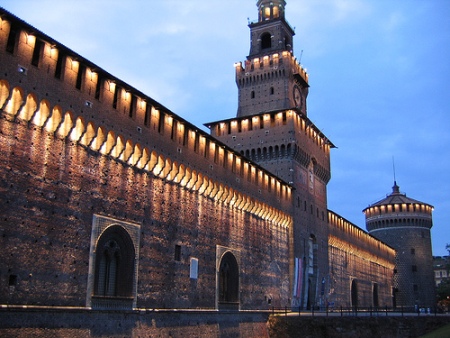
il Castello Sforzesco The Castello Sforzesco's building began in 1368, when Galeazzo Visconti, Lord of Milan, dediced to built a fortress for defensive reasons. In 1450, under the Sforza domain, it had three towers in addition. It was destroyed in 1447 by Milan people, who proclaimed the Repubblica Ambrosiana, as it symbolized the past tyranny.With Francesco Sforza, the castle was rebuilt and became larger and greater. Later, when Ludovico Il Moro succedeed Sforza, the castle became a nodal point of culture and arts of Italian Renaissance, attracting there artist like Bramante and Leonardo da Vinci. 

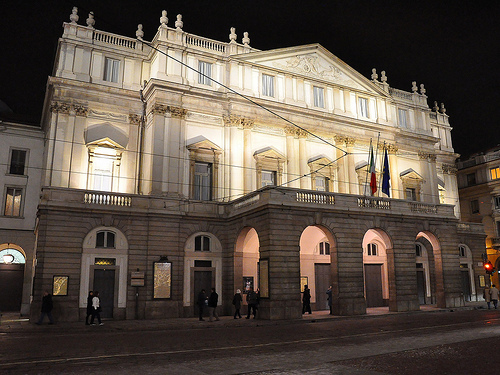
la Scala The "Teatro alla Scala" was built between 1776 and 1778 by Giuseppe Piermarini, a famous neoclassical architect , under the heel of Maria Theresa of Austria; it replaced the Regio Teatro Ducale, which was burn down in 1776.
Its name comes from the church of Santa Maria della Scala, which original site was there. It is the home of the music and opera of Milan. 

the Fashion District Galleria Vittorio Emanuele
It's the "Salon" of Milan, a centre of cultural and mundane activities. It was designed by the architect Giuseppe Marangoni (who died there in 1877) and built between 1865 and 1877. It is shaped as a cross, with an octagon of iron and glass in the middle. There is a particular atmosphere in this old place, full of shops, antique and characteristic restaurants, cafes and bookshops. Look at the floor; in the centre of the Galleria there is a taurus figure: go and whirl on it for three times, you'll get lucky! Via MonteNapoleone
Via Montenapoleone is the most important center of high fashion and shopping of Milan. It's is part, with Via della Spiga, Via Sant'Andrea and Via Pietro Verri, of the fashion four-sided, where you can find the most famous and well-known names of mondial fashion. Before going for shopping, we suggest you to take a cafè or a drink in a caratheristic old cafè, the COVA, founded in 1823. 
|  | 
Visiting Pisa Pisa is best known for its leaning tower but there is much more to see in Pisa, Italy. The area around the cathedral and tower is beautiful and can easily occupy several hours. Pisa was one of the four great maritime republics in the middle ages and retains a good selection of monuments from that era. There's also the Arno River, a university, and several interesting museums. It's a good city for strolling and enjoying at a leisurely pace. 

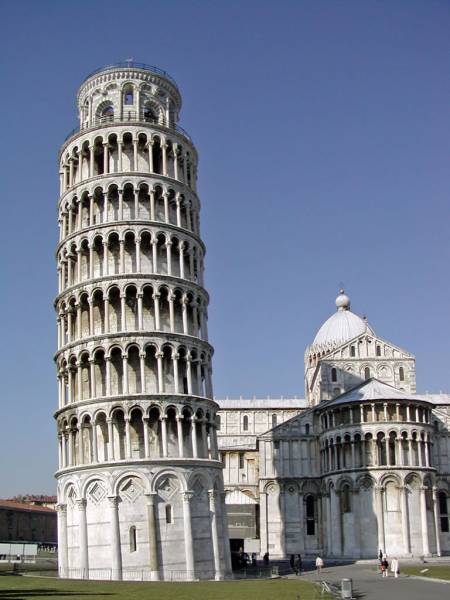
the Leaning Tower The Torre di Pisa or Leaning Tower is one of Europe's most famous towers. Building on the tower started in 1173 but wasn't finished until the late fourteenth century. The cylindrical tower, 54 meters tall, has eight stories, six of them with open galleries. Inside the spiral staircase has 294 steps leading to the top of the tower. 

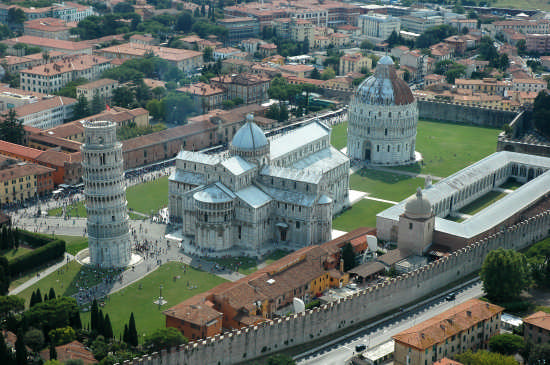
Piazza dei Miracoli Piazza del Duomo or Campo dei Miracoli, Field of Miracles is holds the main attractions of Pisa, one of Europe's greatest groups of Romanesque buildings. The key buildings trace life's path for medieval people from birth to death. The piazza was built outside the main city center but within the still-preserved city walls built in 1155.
The Duomo is an imposing white building dating from 1063. The facade, constructed in the twelfth century, has four tiers of open galleries housing statues and decorated with marble inlay. The doors have bronze panels with bas-reliefs from the sixteenth century. Inside there are a sixteenth century wood ceiling, several important art works, and a magnificent marble pulpit.
The Battistero or Baptistery is a round white-marble building. Construction started in 1152 and was completed in the late fourteenth century with the addition of an eight-sided cupola. The pulpit, supported by lions resting on columns, is decorated with scenes from the life of Christ. Also inside are some impressive statues, originally from the outside.
Camposanto was the cemetery for noble citizens of Pisa. The floor is covered with tombstones and there are many funerary monuments. The portico held many medieval frescoes which were damaged during WWII and removed for restoration. 

Pisa, other attractions Museo dell'Opera del Duomo, at the eastern end of Piazza del Duomo, holds a huge collection of important artworks from these buildings.
Museo Nazionale di San Matteo is in the former Benedictine convent of San Matteo. The museum chronicles the development of medieval Christian painting and sculpture in Europe.
Piazza dei Cavalieri was the center of Pisa in its days as a republic and was remodeled in the sixteenth century, becoming the symbol of Medici power in Pisa. The square has some magnificent sixteenth century buildings, the church of Santo Stefano dei Cavalieri, and the Palazzo dell'Orologio (clock building) with two ancient towers joined by an arcade.
Santa Maria della Spina is a picturesque little church near the river. It has charming spires and high niches with beautiful statues.
Pisa's Botanical Garden is one of the oldest in Europe. 
|  | 
Visiting Rome You need two lifetimes and an extra set of eyes to soak in Rome. For the last two thousand years, this European city has witnessed the birth of Christianity, boasted some of the most important artists in history, created food enjoyed the world over and served as world capital during the Roman Empire.
Rome’s cityscape is drenched in different flavours from the imperial times through the Renaissance and beyond the Baroque periods. When visiting Rome, take time to discover, and allow the city to unfold before you like a living history book. Narrow down to a few attractions to focus your attention on rather than rushing through the city on a breakneck tour determined to see everything.
Begin your exploration in the historic quarters. Grab a good map and put on your best pair of walking shoes. Rome deserves to be discovered on foot. Don’t forget to look up and see the architectural delights and works of art atop buildings and statues. 


il Colosseo Vespasian began construction of this massive colosseum in AD 72. Upon completion eight year later, it could seat 50,000 spectators who came to watch bloody battles between gladiators and wild beasts from home and abroad. Since its inauguration, it has held a special place in the hearts of Romans and has served different purposes including a botanical garden. Now included on the New Seven World Wonders list, the Colosseum begins Rome’s must see list. 

Palatino e Foro Romano Constructed over 900 years, the Roman Forum once held the distinction of commercial, political and religious epicentre. Strolling this immense area allows your mind to comprehend the magnitude of the Roman Empire and the tremendous power the emperors held. Now largely ruins, Rome’s ancient city was in effect dismantled by medieval Romans in the name of progress in order to recycle bricks for new constructions elsewhere in the city. 

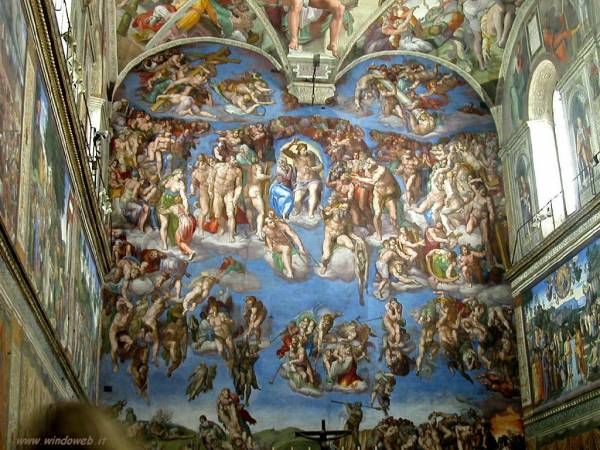
Vaticano e Cappella Sistina The Vatican City, the smallest independent state in the world has its own post office, guard and train station. To this day St. Peter’s Basilica, at the heart of the Vatican City remains the central church of Catholicism. St. Peter is believed to be buried under the building which has been adorned over the centuries with exquisite art including Michelangelo’s Pieta. The Sistine chapel, constructed in 1484 to be used as the conclave that elects popes, contains two pieces of art of unspeakable beauty, Michengelo’s frescoes on the barrel-vaulted ceiling, which took the artist over four years to complete and his last judgement on the end wall completed over thirty years later. Whether you are a Catholic or not it’s a sin not to visit the Sistine Chapel during a tour of Rome. 

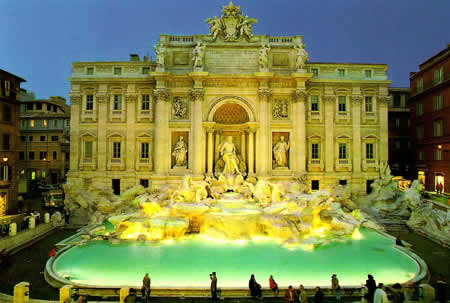
la Fontana di Trevi Rome’s streets overflow with fountains of various degrees of craftsmanship. As much a marvel in architecture as they are art, all the water pumped into this fountain comes from the city’s earliest aqueducts. The fountain dominates a tiny square and, according to custom, if you throw a coin over your shoulder into the water you’re guaranteed a return visit to Rome – not that you’ll need an excuse to go back. 

le Catacombe These underground corridors and passageways were built as a communal burial ground. While mainly Christian, there are some Jewish and pagan catacombs. The most famous of the Christian catacombs are those along the Via Appia Antica. A short bus ride brings you just outside the city where the street is often closed to cars on Sundays allowing for a leisurely stroll and time to soak in the history of the most famous catacomb, San Callisto as well as smaller ones such as the catacombs of San Sebastiano. 
|